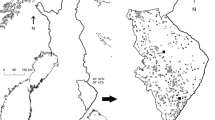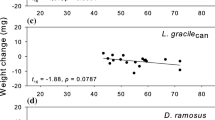Abstract
Indirect exploitative competition, direct interference and predation are important interactions affecting species coexistence. These interaction types may overlap and vary with the season and life-history state of individuals. We studied effects of competition and potential nest predation by common shrews (Sorex araneus) on lactating bank voles (Myodes glareolus) in two seasons. The species coexist and may interact aggressively. Additionally, shrews can prey on nestling voles. We studied bank vole mothers’ spatial and temporal adaptations to shrew presence during summer and autumn. Further, we focused on fitness costs, e.g. decreased offspring survival, which bank voles may experience in the presence of shrews. In summer, interference with shrews decreased the voles’ home ranges and they spent more time outside the nest, but there were no effects on offspring survival. In autumn, we found decreased offspring survival in enclosures with shrews, potentially due to nest predation by shrews or by increased competition between species. Our results indicate a shift between interaction types depending on seasonal constraints. In summer, voles and shrews seem to interact mainly by interference, whereas resource competition and/or nest predation by shrews gain importance in autumn. Different food availability, changing environmental conditions and the energetic constraints in voles and shrews later in the year may be the reasons for the varying combinations of interaction types and their increasing effects on the inclusive fitness of bank voles. Our study provides evidence for the need of studies combining life history with behavioural measurements and seasonal constraints.



Similar content being viewed by others
References
Abramsky Z, Rosenzweig M, Subach A (2001) The cost of interspecific competition in two gerbil species. J Anim Ecol 70:561–567
Amarasekare P (2002) Interference competition and species coexistence. Proceedings of the Royal Society of London Series B—Biological Sciences 269:2541–2550
Amarasekare P, Nisbet R (2001) Spatial heterogeneity, source-sink dynamics, and the local coexistence of competing species. Am Nat 158:572–584
Armstrong RA, McGehee R (1980) Competitive-exclusion. Am Nat 115:151–170
Bajkowska U, Chetnicki W, Fedyk S (2009) Breeding of the common shrew, Sorex araneus, under laboratory conditions. Folia Zoologica 58:1–8
Boonstra R, Krebs C, Kenney A (1996) Why lemmings have indoor plumbing in summer. Canadian Journal of Zoology-Revue canadienne de zoologie 74:1947–1949
Borowski Z, Owadowska E (2010) Field vole (Microtus agrestis) seasonal spacing behavior: the effect of predation risk by mustelids. Naturwissenschaften 97:487–493
Bradley J, Marzluff J (2003) Rodents as nest predators: influences on predatory behavior and consequences to nesting birds. AUK 120:1180–1187
Case TJ, Casten RG (1979) Global stability and multiple domains of attraction in ecological systems. Am Nat 113:705–714
Case T, Gilpin M (1974) Interference competition and niche theory. Proc Natl Acad Sci USA 71:3073–3077
Churchfield S (1982) Food availability and the diet of the common shrew, Sorex araneus, in Britain. J Anim Ecol 51:15–28
Churchfield S (1990) The natural history of shrews. Christopher Helm, London
Connell JH (1983) On the prevalence and relative importance of interspecific competition—evidence from field experiments. Am Nat 122:661–696
Dugatkin L, Godin J (1992) Predator inspection, shoaling and foraging under predation hazard in the Trinidadian guppy, Poecilia-reticulata. Environmental Biology of Fishes 34:265–276
Eadie W (1952) Shrew predation and voles populations on a localized area. J Mammal 33:185–189
Eccard JA, Ylönen H (2002) Direct interference or indirect exploitation? An experimental study of fitness costs of interspecific competition in voles. Oikos 99:580–590
Eccard J, Ylönen H (2003a) Who bears the costs of interspecific competition in an age-structured population? Ecology 84:3284–3293
Eccard JA, Ylönen H (2003b) Interspecific competition in small rodents: from populations to individuals. Evolutionary Ecology 17:423–440
Eccard JA, Ylönen H (2007) Costs of coexistence along a gradient of competitor densities: an experiment with arvicoline rodents. J Anim Ecol 76(1):65–71
Fulk G (1972) Effect of shrews on space utilization of voles. J Mammal 53:461
Getz L, Larson C, Lindstrom K (1992) Blarina-brevicauda as a predator on nestling voles. J Mammal 73:591–596
Gliwicz J, Dabrowski MJ (2008) Ecological factors affecting the diel activity of voles in a multi-species community. Annales Zoologici Fennici 45:242–247
Halle S (1995) Effect of extrinsic factors on activity of root voles, Microtus oeconomus. Journal of Mammalogy 76:88–99
Halle S (2006) Polyphasic activity patterns in small mammals. Folia Primatol 77:15–26
Hansson L (1968) Population densities of small mammals in open field habitats in south Sweden in 1964–1967. Oikos 19:53–60
Hansson L (1985) Clethrionomys food—generic, specific and regional characteristics. Annales Zoologici Fennici 22:315–318
Harris DB, Gregory SD, Macdonald DW (2006) Space invaders? A search for patterns underlying the coexistence of alien black rats and Galapagos rice rats. Oecologia 149:276–288
Henttonen H, Haukisalmi V, Kaikusalo A, Korpimaki E, Norrdahl K, Skaren U (1989) Long-term population-dynamics of the common shrew Sorex-araneus in Finland. Annales Zoologici Fennici 26:349–355
Hoset K, Steen H (2007) Relaxed competition during winter may explain the coexistence of two sympatric Microtus species. Annales Zoologici Fennici 44:415–424
Huitu O, Norrdahl K, Korpimaki E (2004) Competition, predation and interspecific synchrony in cyclic small mammal communities. Ecography 27:197–206
Kaikusalo A (1982) Predatory mammals and vole populations in the fell regions of north-west Finland. Suomen Riista 29:89–92
Kennedy E, White D (1996) Interference competition from house wrens as a factor in the decline of Bewick’s Wrens. Conserv Biol 10:281–284
Kenward RE, Hodder KH (1996) RANGES V: an analysis system for biological location data. Natural Environment Research Council, Swindon, p 66
Koskela E, Mappes T, Ylönen H (1997) Territorial behaviour and reproductive success of bank vole Clethrionomys glareolus females. Journal of Animal Ecology 66:341–349
Lambin X, Yoccoz NG (1998) The impact of population kin-structure on nestling survival in Townsend’s voles, Microtus townsendii. Journal Of Animal Ecology 67:1–16
Laundre J, Hernandez L, Altendorf K (2001) Wolves, elk, and bison: reestablishing the “landscape of fear” in Yellowstone National Park, USA. Canadian Journal of Zoology-Revue canadienne de zoologie 79:1401–1409
Levins R (1979) Coexistence in a variable environment. Am Nat 114:765–783
Liesenjohann T, Eccard JA (2008) Foraging under uniform risk from different types of predators. BMC Ecol 8:19
Lima SL, Valone TJ, Caraco T (1985) Foraging-efficiency predation-risk trade-off in the grey squirrel. Anim Behav 33:155–165
Mappes T, Ylönen H, Viitala J (1995) Higher reproductive success among kin groups of bank voles (Clethrionomys-glareolus). Ecology 76:1276–1282
Mitchell WA (1990) An optimal-control theory of diet selection—the effects of resource depletion and exploitative competition. Oikos 58:16–24
Mitchell WA, Abramsky Z, Kotler BP, Pinshow B, Brown JS (1990) The effect of competition on foraging activity in desert rodents—theory and experiments. Ecology 71:844–854
Nakayama S, Ojanguren AF, Fuiman LA (2009) To fight, or not to fight: determinants and consequences of social behaviour in young red drum (Sciaenops ocellatus). Behaviour 146:815–830
Niethammer J, Krapp F (1982) Handbuch der Säugetiere Europas—Rodentia II, vol 2/I, 1st edn. Akademische Verlagsgesellschaft, Wiesbaden
Norrdahl K, Korpimaki E (2000) The impact of predation risk from small mustelids on prey populations. Mammal Review 30:147–156
Oksanen T, Jonsson P, Koskela E, Mappes T (2001) Optimal allocation of reproductive effort: manipulation of offspring number and size in the bank vole. Proceedings of the Royal Society of London Series B-Biological Sciences 268:661–666
Olsson O, Molokwu MN (2007) On the missed opportunity cost, GUD, and estimating environmental quality. Israel Journal of Ecology & Evolution 53:263–278
Palomares F, Caro TM (1999) Interspecific killing among mammalian carnivores. Am Nat 153:492–508
Pernetta J (1976) Diets of shrews Sorex-araneus L. and Sorex-minutus L. in Wytham-grassland. J Anim Ecol 45:899–912
Polis GA, McCormick SJ (1986) Scorpions, spiders and solpugids: predation and competition among distantly related taxa. Oecologia 71:111–116
Punzo F (2003) Observations on the diet composition of the gray shrew Notiosorex crawfordi (Insectivora), including interactions with large arthropods. Texas Journal of Science 55:75–86
Ricklefs RE (1969) Natural selection and development of mortality rates in young birds. Nature 223:922–925
Ruzic A (1971) Spitzmäuse als Räuber der Feldmaus Microtus arvalis (Pallas, 1779). Säugetierkundliche Mitteilungen 19:366–370
Rychlik L, Jancewicz E (2002) Prey size, prey nutrition, and food handling by shrews of different body sizes. Behavioral Ecology 13:216–223
Scharf I, Filin I, Ovadia O (2008) An experimental design and a statistical analysis separating interference from exploitation competition. Population Ecology 50:319–324
Schoener TW (1983) Field experiments on interspecific competition. Am Nat 122:240–285
Shenbrot G, Krasnov B (2002) Can interaction coefficients be determined from census data? Testing two estimation methods with Negev Desert rodents. OIKOS 99:47–58
Smallegange I, van der Meer J, Kurvers R (2006) Disentangling interference competition from exploitative competition in a crab–bivalve system using a novel experimental approach. Oikos 113:157–167
Torres PF, Eterovick PC (2010) Anuran assemblage composition and distribution at a modified environment in Tres Marias reservoir, south-eastern Brazil. Journal of Natural History 44:2649–2667
Triplet P, Stillman R, Goss-Custard J (1999) Prey abundance and the strength of interference in a foraging shorebird. J Anim Ecol 68:254–265
Valeix M, Chamaille-Jammes S, Fritz H (2007) Interference competition and temporal niche shifts: elephants and herbivore communities at waterholes. Oecologia 153:739–748
Viitala J (1984) The red vole, Clethrionomys rutilus (Pall.), as a subordinate member of the rodent community at Kilpisjärvi, Finnish Lapland. Acta Zool Fenn 172:67–70
Walls S (1990) Interference competition in postmetamorphic salamanders—interspecific differences in aggression by coexisting species. Ecology 71:307–314
Wolff JO (1993) Why are female small mammals territorial. Oikos 68:364–370
Wolff J, Bateman G (1978) Effects of food availability and ambient temperature on torpor cycles of Perognathus flavus (Heteromyidae). J Mammal 59:707–716
Wolff JO, Peterson JA (1998) An offspring-defense hypothesis for territoriality in female mammals. Ethology Ecology & Evolution 10:227–239
Wolff JO, Schauber EM (1996) Space use and juvenile recruitment in gray-tailed voles in response to intruder pressure and food abundance. Acta Theriol 41:35–43
Ylönen H (1990) Phenotypic flexibility in the social organization of Clethrionomys. In: Tamarin R, Ostfeld R, Pugh S, Bujalska G (eds) Social systems and population cycles in voles. Birkhäuser, Basel, pp 203–212
Ylönen H, Viitala J (1985) Social-organisation of an enclosed winter population of the bank vole Clethrionomys-glareolus. Annales Zoologici Fennici 22:353–358
Ylönen H, Viitala J (1991) Social overwintering and food distribution in the bank vole Clethrionomys-glareolus. Holarctic Ecology 14:131–137
Ylönen H, Kojola T, Viitala J (1988) Changing female spacing behaviour and demography in an enclosed breeding population of Clethrionomys glareolus. Holarctic Ecology 11:286–292
Ylönen H, Horne T, Luukkonen M (2004) Effect of birth and weaning mass on growth, survival and reproduction in the bank vole. Evolutionary Ecology Research 6:433–442
Zeng XH, Lu X (2009) Interspecific dominance and asymmetric competition with respect to nesting habitats between two snowfinch species in a high-altitude extreme environment. Ecological Research 24:607–616
Ziv Y, Abramsky Z, Kotler B, Subach A (1993) Interference competition and temporal and habitat partitioning in 2 gerbil species. Oikos 66:237–246
Acknowledgements
This study was supported by the German Science Foundation (grand to JAE ec361/4-1).
Author information
Authors and Affiliations
Corresponding author
Additional information
Communicated by E. Korpimäki
Rights and permissions
About this article
Cite this article
Liesenjohann, M., Liesenjohann, T., Trebaticka, L. et al. From interference to predation: type and effects of direct interspecific interactions of small mammals. Behav Ecol Sociobiol 65, 2079–2089 (2011). https://doi.org/10.1007/s00265-011-1217-z
Received:
Revised:
Accepted:
Published:
Issue Date:
DOI: https://doi.org/10.1007/s00265-011-1217-z




